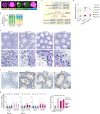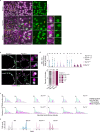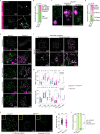Intercellular bridges are essential for transposon repression and meiosis in the male germline
- PMID: 39929837
- PMCID: PMC11811169
- DOI: 10.1038/s41467-025-56742-9
Intercellular bridges are essential for transposon repression and meiosis in the male germline
Abstract
Germ cell connectivity via intercellular bridges is a widely conserved feature across metazoans. However, its functional significance is poorly understood. Intercellular bridges are essential for fertility in male mice as genetic ablation of a critical bridge component, TEX14, causes spermatogenic failure, but the underlying reasons are unknown. Here we utilized a Tex14 hypomorph with reduced intercellular bridges along with Tex14-null mice that completely lack bridges to examine the roles of germ cell connectivity during spermatogenesis. We report that in males deficient for TEX14 and intercellular bridges, germ cells fail to complete meiotic DNA replication, synapsis and meiotic double-strand break repair. They also derepress retrotransposons and accumulate retrotransposon-encoded proteins during meiosis. Single-cell RNA-sequencing confirms sharing of transcripts between wild-type spermatids and demonstrates its partial attenuation in Tex14 hypomorphs, indicating that intercellular bridges enable cytoplasmic exchange between connected germ cells in testes. Our findings suggest that regulation of meiosis is non-cell-intrinsic and inform a model in which intercellular bridges influence critical meiotic events and protect germline genome integrity during spermatogenesis.
© 2025. The Author(s).
Conflict of interest statement
Competing interests: The authors declare no competing interests.
Figures








References
MeSH terms
Substances
Grants and funding
- Intramural research program/U.S. Department of Health & Human Services | NIH | National Institute of Diabetes and Digestive and Kidney Diseases (National Institute of Diabetes & Digestive & Kidney Diseases)
- R35 GM152168/GM/NIGMS NIH HHS/United States
- R35 GM147130/GM/NIGMS NIH HHS/United States
- R01 HD113274/HD/NICHD NIH HHS/United States
- R01 HD104680/HD/NICHD NIH HHS/United States
LinkOut - more resources
Full Text Sources
Molecular Biology Databases

